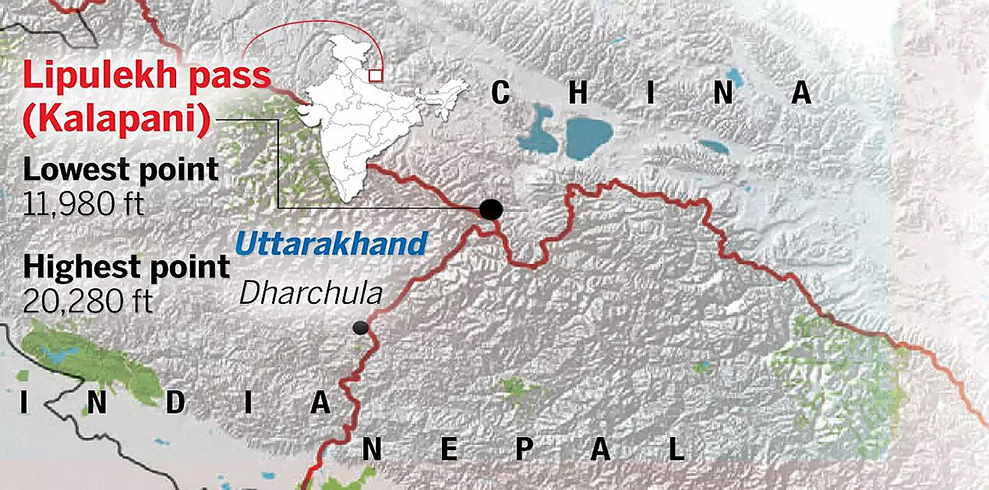International Relations
New Bridge: India & Nepal
- 08 Jan 2022
- 7 min read
For Prelims: Kali River, India-Nepal Treaty of Peace and Friendship of 1950, Dharchula Bridge.
For Mains: Significance and Challenges of India- Nepal Relations.
Why in News
Recently, the Union Cabinet has cleared a plan to build a new bridge connecting India and Nepal over the Mahakali river and link Dharchula in Uttarakhand with Nepal’s Dharchula.
Key Points
- About

- The bridge will be completed within three years. It will strengthen the relationship between the two countries.
- India and Nepal share unique ties of friendship and cooperation.
- The construction of the bridge will help people living in Dharchula in Uttarakhand and in the territory of Nepal.
- Mahakali River:
- It is also known as Sharda river or Kali Ganga in Uttarakhand.
- It joins Ghagra river in Uttar Pradesh, which is a tributary of Ganga.
- River Projects: Tanakpur hydro-electric project, Chameliya hydro-electric project, Sharda Barrage.
India - Nepal Relations
- Historical Ties:
- Nepal is an important neighbour of India and occupies special significance in its foreign policy because of the geographic, historical, cultural and economic linkages/ties that span centuries.
- India and Nepal share similar ties in terms of Hinduism and Buddhism with Buddha’s birthplace Lumbini located in present day Nepal.
- The two countries not only share an open border and unhindered movement of people, but they also have close bonds through marriages and familial ties, popularly known as Roti-Beti ka Rishta.
- The India-Nepal Treaty of Peace and Friendship of 1950 forms the bedrock of the special relations that exist between India and Nepal.
- Importance for India can be studied from two different angles: a) their strategic importance for India’s national security, and b) their place in India’s role perception in international politics.
- Rivers originating in Nepal feed the perennial river systems of India in terms of ecology and hydropower potential.
- Trade and Economy:
- India is Nepal’s largest trade partner and the largest source of foreign investments, besides providing transit for almost the entire third country trade of Nepal.
- Connectivity:
- Nepal being a landlocked country, it is surrounded by India from three sides and one side is open towards Tibet which has very limited vehicular access.
- India-Nepal has undertaken various connectivity programs to enhance people-to-people linkages and promote economic growth and development.
- MOUs have been signed between both the governments for laying an electric rail track linking Kathmandu with Raxaul in India.
- India is looking to develop the inland waterways for the movement of cargo, within the framework of trade and transit arrangements, providing additional access to sea for Nepal calling it linking Sagarmatha (Mt. Everest) with Sagar (Indian Ocean).
- Defence Cooperation
- Bilateral defence cooperation includes assistance to Nepalese Army in its modernization through provision of equipment and training.
- The Gorkha Regiments of the Indian Army are raised partly by recruitment from hill districts of Nepal.
- India from 2011, every year undertakes joint military exercise with Nepal known as Surya Kiran.
- Cultural
- There have been initiatives to promote people-to-people contacts in the area of art & culture, academics and media with different local bodies of Nepal.
- India has signed three sister-city agreements for twinning Kathmandu-Varanasi, Lumbini-Bodhgaya and Janakpur-Ayodhya.
- A sister city or twin town relationship is a form of legal or social agreement between two geographically and politically distinct localities.
- Humanitarian Assistance
- Nepal lies in a sensitive ecological fragile zone which is prone to earthquakes, floods causing massive damage to both life and money, whereby it remains the biggest recipient of India’s humanitarian assistance.
- Multilateral Partnership
- India and Nepal share multiple multilateral forums such as BBIN (Bangladesh, Bhutan, India, and Nepal), BIMSTEC (Bay of Bengal Initiative for Multi Sectoral Technical and Economic Cooperation), Non Aligned Movement, and SAARC (South Asian Association for Regional Cooperation) etc.
- Issues & Challenges
- China’s Intervention:
- As a landlocked nation, Nepal depended for many years on Indian imports, and India played an active role in Nepal's affairs.
- However, in recent years, Nepal has drifted away from India's influence, and China has gradually filled the space with investments, aid and loans.
- China considers Nepal a key partner in its Belt and Road Initiative (BRI), and wants to invest in Nepal's infrastructure as part of its grand plans to boost global trade.
- Rising Nepal and China cooperation can undermine Nepal’s distinction of buffer state between India and China.
- China on the other hand wants to avoid the formation of any Anti-China stance by the Tibetans living in Nepal.
- Border Dispute:
- The issue erupted in November 2019 when Nepal had released a new political map that claims Kalapani, Limpiyadhura and Lipulekh of Uttarakhand as part of Nepal’s territory. The area of Susta (West Champaran district, Bihar) can also be noted in the new map.
- China’s Intervention:
Way Forward
- India should negotiate diplomatically to resolve the boundary dispute with Nepal under the aegis of International law on Trans-boundary Water Disputes. In this case, boundary dispute resolution between India and Bangladesh should serve as a model.
- India should engage more proactively with Nepal in terms of people to people engagement, bureaucratic engagement as well as political interactions.
- Mere differences shall not turn into disputes and both the countries should resolve the issues peacefully.




